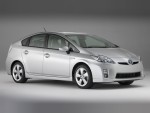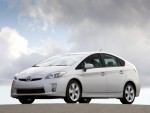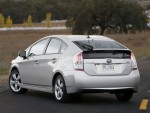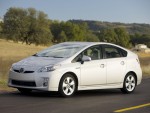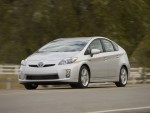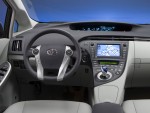2010 Toyota Prius
2010 Toyota Prius Pictures & Specifications
Home »
Toyota
Picture Gallery
Technical Specifications
Make: Toyota
Model: Prius
Engine: 1.8 litre four-cylinder petrol electric hybrid
Aspiration: Natural
Maximum Power: 98 hp (73 kW) @ 5200 rpm
Maximum Torque: 105 lb-ft (142 Nm) @ 4000 rpm
Electric Motor Maximum Power: 80 hp (60 kW)
Electric Motor Maximum Torque: 153 lb-ft (207 Nm)
Hybrid System Combined Power: 134 hp (100 kW)
Transmission: Electronically controlled continuously variable automatic
Drivetrain: Front-wheel drive
Toyota Unveils Next-Generation Hybrid
Toyota Press Release
13 January 2009
Toyota unveiled the third-generation Prius hybrid vehicle today (Australian time) at the 2009 North American International Auto Show in Detroit.
A benchmark for cars of the future, Prius has delivered superior fuel economy and ultra-low emissions to more than one million owners worldwide, including almost 12,000 in Australia.
The third-generation 2010 Prius is expected to arrive on the Australian market early in the third quarter of 2009.
It features even better fuel economy and stronger performance with styling that is sharper, sportier and more aerodynamic than its predecessors.
New Prius will be quieter, roomier and equipped with advanced standard and available features such as steering-wheel touch controls that have read-outs on the instrument panel display, and a moon-roof with solar panels.
The third-generation car will introduce several world and Toyota firsts, including best aerodynamic profile of any mass-produced vehicle in the world, with a coefficient of drag (Cd) of just 0.25.
Enhanced performance will come from a 1.8-litre Atkinson-cycle four-cylinder engine, which is larger and produces more power and torque than the existing 1.5-litre engine.
Contrary to conventional wisdom, the larger engine actually helps improve fuel economy. By producing more torque, the new engine can run more efficiently on the highway – operating at lower rpm and using less fuel. Fuel economy has also been improved in cold-start conditions and at higher speeds.
Toyota’s testing indicates the new Prius will accelerate from standstill to 100km/h approximately one second faster than the current car.
Despite the bigger engine and stronger performance, overseas figures indicate a fuel-economy gain of around nine per cent – a remarkable achievement.
The patented Hybrid Synergy Drive system in the new Prius is 90 per cent newly developed and provides significant improvements.
Unlike most other hybrid vehicles, Prius is a “full” hybrid. It can run on engine alone, battery alone, or a combination of both. It can also charge the batteries while the car is running.
Toyota Australia’s corporate manager product planning Peter Evans said the unveiling of the new Prius heralded an exciting 12 months for Toyota and its Hybrid Synergy Drive technology.
“New-generation Prius will appeal to a wider group of owners by using even less fuel, while meeting customer expectations for better performance and projecting a style that is more mainstream while being unmistakably Prius,” he said.
“This is a car that will fulfil the varied demands of many customers – whether their priority is a car with ultra-low emissions, excellent city and highway performance or more space for their families and luggage,” Mr Evans said.
“New Prius delivers all of these requirements without compromise.
“Of course, the benefits of Toyota’s Hybrid Synergy Drive technology will be available to even more Australian motorists early next year when we launch our locally manufactured hybrid Camry.”
New Prius in detail
The first-generation Prius was launched in Japan in 1997 as the world’s first mass-produced hybrid. The name Prius, “to go before” in Latin, became symbolic of a car that was launched even before environmental awareness had become a mainstream social issue.
From the beginning, Toyota’s full-hybrid system was developed in-house and has become a driving force behind advanced vehicle technology.
In designing the new, third-generation Prius, Toyota engineers combined a careful refinement of existing systems with an aggressive measure of new technology necessary for the future of automobiles.
Fuel Economy and Environmental Performance
The new Prius will be built using processes that reduce pollution in every stage of vehicle life, from development, production and driving, through to disposal.
The third-generation Prius extends its record of continuous improvement in fuel economy. Using a combination of technologies, fuel efficiency is expected to show an improvement of at least nine per cent compared with the current car’s 4.4 litres/100km rating.
The 1.8-litre Prius engine is the first Toyota powerplant that requires no belts under the hood for better fuel economy and less potential maintenance.
Use of an electric water pump and a new exhaust heat recovery system also contribute to the engine’s efficiency.
A multi-information display panel that monitors fuel and energy consumption is standard. The panel provides feedback on efficiency using three different displays to help the driver acquire economical driving habits.
New Prius will offer three alternative driving modes. EV Mode allows driving on battery power alone for up to2km, if conditions permit. Power Mode increases sensitivity to throttle input for a sportier feel, and Eco Mode helps drivers achieve their best fuel economy.
Cutting-Edge Styling
In designing the new Prius, aerodynamic performance was an important factor. The goal was to create a beautiful silhouette, while not compromising function.
Designers preserved the dynamic triangle form of the current model while altering the overall profile, pillar position and angle. The front pillar, extended forward, helps refine the performance-focusing, shaped form.
The overall height of the Prius is the same, but the roof profile is altered by moving the highest point of the roof 99 mm to the rear. This emphasises the wedge shape and also allows for enhanced rear headroom and improved aerodynamics.
Strong side character lines, rising from front to rear, define the glazed geometric shape. Viewed from the rear, wider rear treads provide a solid, firmly rooted stance.
New Prius has the same wheelbase as the current generation. Overall length is slightly increased by 15 mm, in part by moving the front cowl forward.
World’s Lowest Cd
The new Prius received more wind-tunnel hours of testing than any other Toyota in history, resulting in the cleanest aerodynamic profile of any mass-produced vehicle in the world.
By focusing on the shape of the body, underfloor, wheelhouse liner and the wheels, designers were able to reduce the coefficient of drag (Cd) to 0.25, compared with 0.26 for the current model.
Airflow under the car was studied extensively. Engineers made changes to the shape of the fender liner, front surface of the underfloor and added a fin at the rear floor cover to increase linear stability as development progressed.
Advanced Equipment for a New Era
An available sliding glass moonroof is packaged with solar panels, located over the rear seating area, that power a new ventilation system.
This solar-powered ventilation system uses an electrically powered air circulation fan that does not require engine assist. The system prevents the interior air temperature from rising while the vehicle is parked, making the cool-down time shorter when the driver returns to the vehicle, thus reducing the use of air-conditioning.
A remote air-conditioning system is the first system in the world to function on battery-power alone and that can be remotely operated – so the driver can adjust the interior temperature for comfort before getting in the car.
Reducing the vehicle’s power consumption, available LED (light-emitting diode) lamps are used for low beams and also in the tail and stop lamps.
Air-conditioning, a major energy drain, has been re-engineered to increase efficiency and cool-down performance. In addition, an exhaust heat recovery system reduces heat waste by warming engine coolant during cold start-up, for improved economy by allowing earlier petrol engine shutdown on overrun and in stop-start traffic. It also heats up the passenger cabin more efficiently.
Enhanced Vehicle Performance
The next-generation Prius is built on a new platform, which enables improved handling, stability, quieter operation and collision safety.
Functional Interior
Proving that small changes add up to big gains, the cargo area of the new Prius was expanded 10 mm in length and 56 mm in width by using a new and improved layout of the battery-cooling unit.
Rear-seat legroom is enhanced by a new space-saving contoured front-seat design.
Touch sensors on the steering-wheel switches are designed to reduce driver eye movement for better concentration on the road. When the driver touches the audio or info switch located on the steering wheel, a duplicate image is displayed on the instrument panel, directly in front of the driver. This system, called Touch Tracer, is the first system in the world to allow steering-wheel controls to read out on the instrument panel.
The ECO indicator on the Multi-Informational Display (MID) provides driver feedback for lower fuel consumption.
Safety Enhancements
The new Prius was designed to comply with class top-level collision safety performance in each global region of sale, and to accommodate increasingly strict safety requirements in the future.
Front and rear side-curtain airbags, driver and passenger-mounted side airbags and knee airbags are available, in addition to advanced driver and front-passenger Supplemental Restraint System (SRS) airbags. Active headrests are used in both front seats to reduce the possibility of whiplash in a collision. Other available safety features include Anti-lock Brake System (ABS), Electronic Brakeforce Distribution (EBD), Brake Assist (BA), electronic traction control (TRAC) and Vehicle Stability Control (VSC).
New Prius will offer Dynamic Radar Cruise Control, using advanced millimetre wave radar. The system also enables the Pre-Collision System, which retracts seatbelts and applies the brakes in certain conditions when a crash is unavoidable.
New-generation Intelligent Parking Assist is available with simplified settings to guide the car into parking spaces.
A rear-view camera, which provides a view of obstacles when reversing, is available with the voice-activated navigation system.
The development of the Prius has required applications for more than 1,000 patents filed across the world, of which 292 are U.S. applications.
2010 Prius Preliminary Specifications (U.S. Model)
Powertrain
1.8-litre four-cylinder engine with VVT-i
Engine horsepower: 98 hp (73 kW) @ 5,200rpm
Engine torque: 105 lb-ft (142 Nm) @ 4,000rpm
Electric motor: Permanent magnet synchronous motor
Electric motor power output: 80 hp/153 lb-ft torque (60 kW/207 Nm)
Hybrid system net horsepower: 134 hp (100 kW)
Emission rating: SULEV (with AT-PZEV)
Electronically controlled continuously variable transmission
Drive system: Front-wheel drive
Hybrid battery pack: Nickel-metal hydride
Dimensions (inches)
Overall length: 175.6 (4460 mm)
Overall Width: 68.7 (1745 mm)
Overall Height: 58.3 (1480 mm)
Wheelbase: 106.3 (2700 mm)
Ground clearance: 5.5 (139.7 mm)
Co-efficient of Drag: 0.25
Wheels: 15-inch alloy wheels
Tyre size: 195/65 R15
Seating capacity: 5
